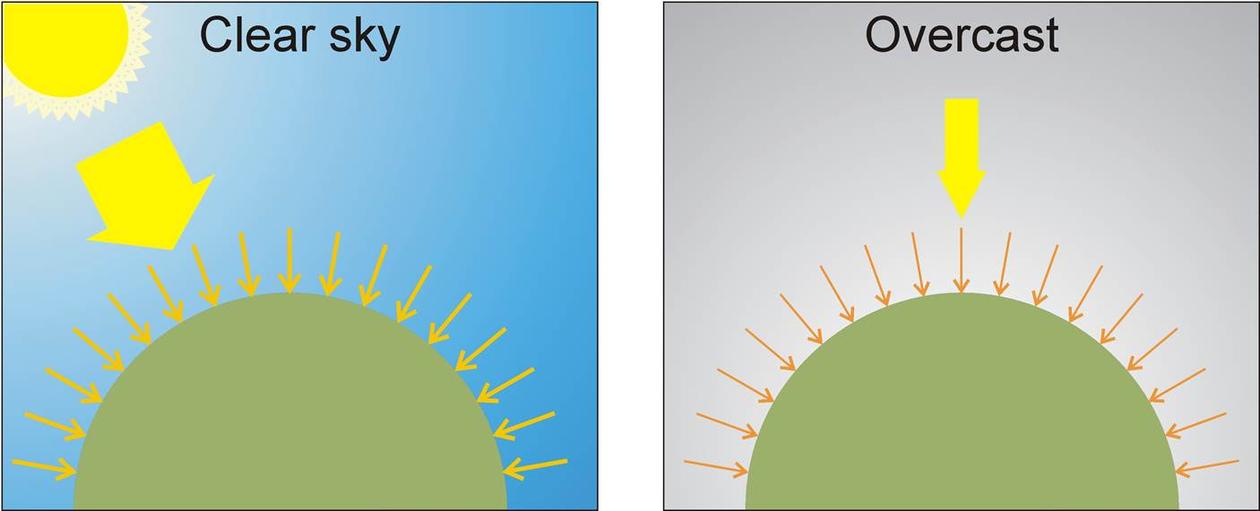Radiation modelling
For economic reasons, the density of ground based stations measuring radiation is limited. Besides, parameters needed for environmental studies do often not exist from measurements, but have to be derived from other measured quantities. Thus, it is important to develop models that can help us to fill the gaps.

Main content
Calculations of atmospheric radiative transfer can be done by line-by-line or band models for radiative transfer (libRadtran, SBDART, MODTRAN, ...). As calculations by such models are time-consuming, simpler bulk models for the radiative transfer, are valuable. At GFI, an important task within radiation research is to develop simpler models to derive the requested radiation data. This makes it possible to increase the amount of radiation data for different applications. As an example, the solar energy community needs reliable data on the solar energy recourses, with a high spatial and temporal resolution. Besides, for other environmental studies, the data needed are often not available from measurements.
To cover this demand on more detailed solar radiation data, there has been and still is a focus on development and testing of models to produce these data. The models available, are models to derive:
Solar radiation data at the surface from satellite observations
To increase the spatial and temporal resolution of solar irradiance data, models for estimation of ground based solar radiation from the geostationary satellite METEOSAT has been developed. This work was done through the EU-projects Sate-Light and Heliosat3, where GFI participated. At the webpage of the project Sate-Light 15-min solar radiation data are given for the 5-year period 1996 - 2000 for most parts of Europe. Examples of publications on this work are found here: paper1, paper2, paper3, paper4 .
Solar radiation data from surface observed cloud information
Until recently, the number of cloud observing stations was larger than the number of stations measuring solar radiation. Besides, clouds have a large impact on the solar radiation. Thus, to increase the amount of radiation data, a model for estimation of solar radiation from surface observed cloud information is available at GFI. More on this model, see here: paper.
The diffuse fraction of solar radiation
While many radiation stations only have measurements of total solar radiation on a horizontal surface (global radiation) data on the insolation on inclined surfaces are often needed. Then, the diffuse and the direct fraction of this horizontal radiation has to be known (paper1, paper2).
The solar radiation on inclined surfaces
Based on the diffuse and the direct component of the global radiation, a slope model can be used to estimate the solar radiation on inclined surfaces, with different sloping angles and orientention. For more information, see: paper1, paper2, paper3 .
The spectral distribution (illuminances, PAR, UV) of solar radiation
For different purposes (solar energy studies, agricultural studies, health studies etc.) spectral data are needed. As measurements of such data are more rare than measured data on the total solar radiation, there is a need to model the spectral data from the total solar radiation data. Such models exist at GFI, and for more information, see: paper1, paper2, paper3, paper4.
Short term variations of solar radiation
Solar radiation data often exist on a time resolution (monthly, daily, hourly averages) which is too long for many purposes. Possible questions in such cases could be:
- if only monthly averages are known, is it then possible to estimate the variations of daily values within this month?
- if only hourly averages are known, is it then possible to estimate the variations of 5-minute values within this hour?
Models dealing with this problem are found here: paper1, paper2 ,
Variability of solar radiation in a complex terrain
Both for solar energy utilization and for agricultural investigations, the spatial variability of solar radiation in a complex terrain is important. Then, both screening effects of the elevated horizon and the effect of inclination angle and orientation of the terrain surface, must be taken into consideration. More on this variabiliy, you will find here: paper1, paper2 .
Long wave atmospheric radiation from standard meteorological data
As standard meteorological parameters (like air temperature and humidity at 2 m above ground) are measured frequently, numerous simple models for estimation of clear sky long wave atmospheric radiation from these parameters exist. At GFI, these models have been tested, both against measured data and against the spectral radiative transfer model MODTRAN. For the results, see paper .
Contact at GFI: Jan Asle Olseth
